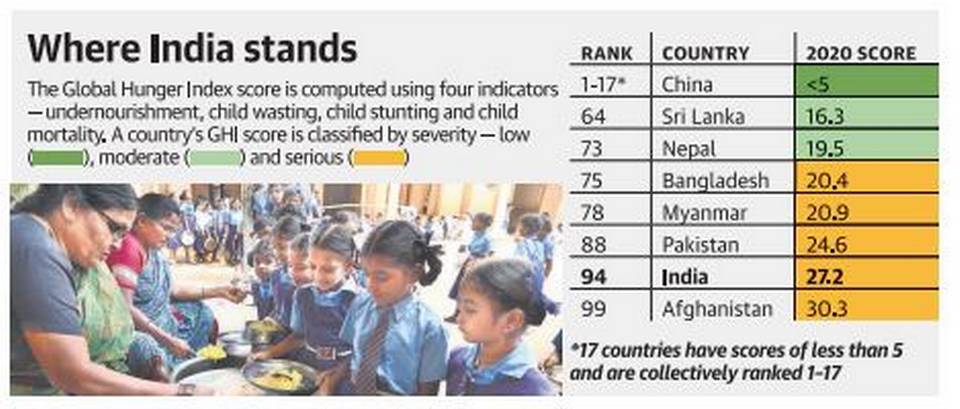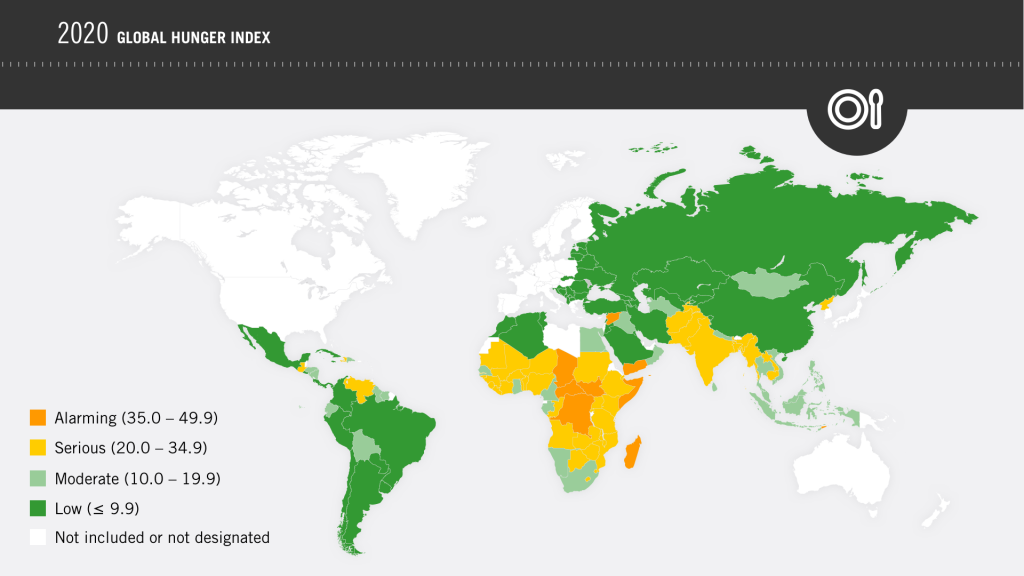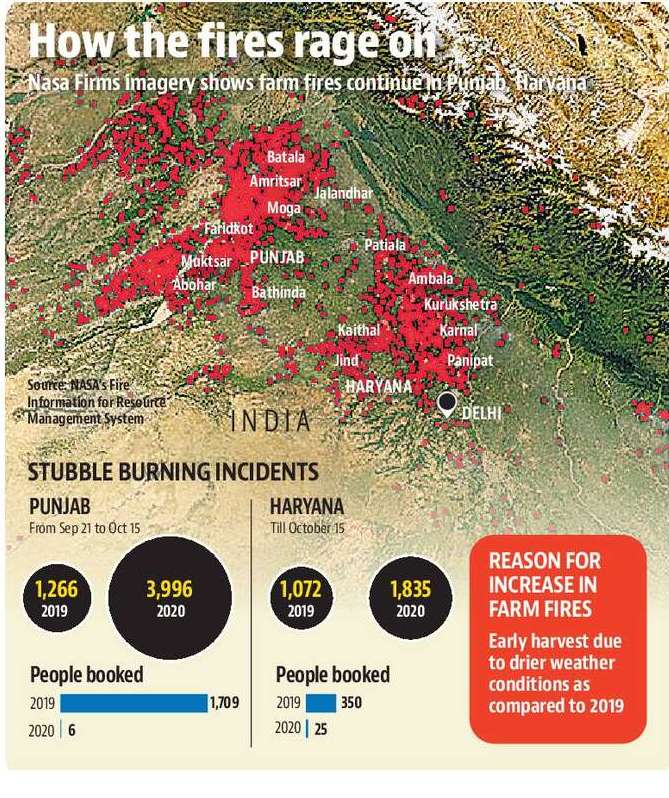Contents
- Global Hunger Index 2020
- International Day for the Eradication of Poverty
- Stubble Burning: One-man panel
- National Oilseed Mission
GLOBAL HUNGER INDEX 2020
Focus: GS-II Social Justice
Why in news?
India has the highest prevalence of wasted children under five years in the world, which reflects acute undernutrition, according to the Global Hunger Index 2020.
Highlights
- The situation has worsened in the 2015-19 period, when the prevalence of child wasting was 17.3%, in comparison to 2010-14, when it was 15.1%.
- Overall, India ranks 94 out of 107 countries in the Index, lower than neighbours such as Bangladesh (75) and Pakistan (88).
- 2020 scores reflect data from 2015-19.
- India fares worst in child wasting (low weight for height, reflecting acute undernutrition) and child stunting (low height for age, reflecting chronic undernutrition), which together make up a third of the total score.
- Although it is still in the poorest category, however, child stunting has actually improved significantly, from 54% in 2000 to less than 35% now.
- Child wasting, on the other hand, has not improved in the last two decades, and is rather worse than it was decade ago.
- India has improved in both child mortality rates, which are now at 3.7%, and in terms of undernourishment, with about 14% of the total population which gets an insufficient caloric intake.
- In the region of south, east and south-eastern Asia, the only countries which fare worse than India are Timor-Leste, Afghanistan and North Korea.
Global Hunger Index (GHI) 2020
- The Global Hunger Index (GHI) is a tool that measures and tracks hunger globally as well as by region and by country.
- The GHI is calculated annually, and its results appear in a report issued in October each year.
- After declining since 2000, hunger at the global level is classified as moderate, according to the 2020 report.
- Many individual countries have also achieved reductions in hunger since 2000, but in some countries hunger persists or has even worsened.
- The 2020 Global Hunger Index report presents a multi-dimensional measure of national, regional, and global hunger by assigning a numerical score based on several aspects of hunger.
- It then ranks countries by GHI score and compares current scores with past results.
- Besides presenting GHI scores, each year the GHI report includes an essay addressing one particular aspect of hunger.
- The 2020 report considers a One Health approach to linking health and sustainable food systems in order to achieve Zero Hunger by 2030.
- GHI uses four parameters to determine its scores.
- Globally, nearly 690 million people are undernourished, according to the report, which warns that the COVID-19 pandemic could have affected the progress made on reducing hunger and poverty.
The GHI combines 4 component indicators:
- the proportion of the undernourished as a percentage of the population;
- the proportion of children under the age of five suffering from wasting, a sign of acute undernutrition;
- the proportion of children under the age of five suffering from stunting, a sign of chronic undernutrition; and
- the mortality rate of children under the age of five.


-Source: The Hindu
INTERNATIONAL DAY FOR THE ERADICATION OF POVERTY
Focus: GS-II Social Justice
Why in news?
- October 17, 2020, was observed as the International Day for the Eradication of Poverty at a time when the COVID-19 pandemic has undone years of gains in reducing poverty across the world.
- The International Day for the Eradication of Poverty is an international observance celebrated each year on October 17 throughout the world.
- This year’s theme: ‘Acting Together to Achieve Social and Environmental Justice for All’
Details
- More than 90 per cent countries have reported a dip in per capita income — due to the novel coronavirus disease (COVID-19) pandemic and the ensuing economic disruptions.
- Notwithstanding the renewed focus on the current spike in poverty, the world was not on a fast path to poverty eradication as we aspire to achieve by 2030.
- A Food and Agriculture Organization (FAO) study shows that more than a billion people are forest-dependent, and most of them survive below the poverty line.
- Poverty in absolute terms is increasing in areas usually associated with the likes of sub-Saharan Africa and South Asia.
- At the global level, just five countries—India, Bangladesh, Nigeria, Ethiopia and the Democratic Republic of Congo—account for half of the extreme poor in the world.
The Ecology of Poverty
The current geography of the poor has two situational realities.
- One is that the poor reside mostly in rural areas. Going by the Bank’s report, three-fourths of the total poor live in rural areas.
- Secondly, these places have a highly degraded ecology. Most of the poor depend on natural resources like land, forests and livestock for survival. So, for them, economy is all about ecology. Degradation of the ecology, thus, leads to poverty.
Absence of poverty data in India
- The World Bank’s biennial Poverty and Shared Prosperity Report: Reversals of Fortune was released and the findings show that for the first time in two decades, global poverty rate would go up due to the novel coronavirus disease (COVID-19) pandemic.
- The multilateral body couldn’t gauge the real poverty situation in the world because India did not have latest data. Or, in simple terms, India has stopped counting its poor.
- The report said that lack of recent data for India severely hinders the ability to monitor global poverty.
- India, along with Nigeria, is considered to have the largest number of the poor in the world.
- India tops the global list in terms of absolute number of poor, going by the last national survey of 2012-13.
- The country accounted for 139 million of the total 689 million people living in poverty in 2017.
- It is, thus, imperative that if the world has to meet its United Nations-mandated Sustainable Development Goal (SDG) I to eradicate poverty by 2030, India has to achieve this goal first.

-Source: Down to Earth
STUBBLE BURNING: ONE-MAN PANEL
Focus: GS-III Environment and Ecology
Why in news?
The Supreme Court Friday appointed retired apex court judge Justice Madan B Lokur as a one-man committee to take steps for preventing stubble burning in Punjab, Haryana and Uttar Pradesh which is a source of pollution in Delhi-national capital region (NCR).
Details
- The apex court directed the court-appointed Environment Pollution Control Authority (EPCA) and chief secretaries of Haryana, Punjab and Uttar Pradesh to assist the Lokur panel to enable physical surveillance of fields where stubble is burnt.
- The top court directed the states concerned to provide adequate security, secretarial infrastructure and transport to Lokur panel.
Farm fires increase in Punjab, Haryana despite assurances
- This year, the stubble burning in Punjab and Haryana has gone unabated primarily because of the reluctance of the local administration to act against offenders due to ongoing farmer protests in the two states.
- In 2020 the stubble burning in Punjab and Haryana has gone unabated primarily because of the reluctance of the local administration to act against offenders due to ongoing farmer protests in the two states.
- Delhi and its neighbouring areas are grappling with deteriorating air quality that could aggravate the Covid-19 pandemic in the region, officials said.
- Haryana has done slightly better that Punjab with 71% more stubble burning incidents for same period.
- Farmers burn paddy stubble to clear the fields for sowing of winter wheat crop, 90% of which is procured by the government to sustain the Public Distribution System (PDS).
- The fires send fumes into air causing massive pollution across the entire northern plains.
- In Haryana, the number of farmers booked this year is about 60% less than last year.
-Source: Hindustan Times
NATIONAL OILSEED MISSION
Focus: GS-III Agriculture
Why in news?
- The delay in the roll out of the National Oilseed Mission was hurting India’s edible oil security, Solvent Extractors’ Association of India (SEA).
- To curb imports, the SEA had been advocating cultivation of soybean, sunfower, maize and mustard in Punjab and Haryana via a shift in crop pattern from rice in kharif and wheat in rabi season.
National Mission on Oilseeds and Oil Palm (NMOOP)
- India is one of the major oilseeds grower and importer of edible oils. India’s vegetable oil economy is the world’s fourth-largest after USA, China & Brazil.
- But a substantial portion of our requirement of edible oil is met through import of palm oil from Indonesia and Malaysia hence government of India implemented the National Mission on Oilseeds and Oil Palm (NMOOP) during the 12th Five Year Plan, to expand the oil palm areas and increase the production of edible oils
Mini Missions and their targets
- The NMOOP was launched under Mini Missions (MM) I, II & III to achieve the following specific targets;
- Under the MM–I, the mission aims to increase the production of oilseeds to 35.51 million tonnes from the current average production of 28.93 million tonnes of oilseeds.
- Under the MM–II, the mission’s target is to broaden the area for oil palm cultivation and boost the production of Fresh Fruit Bunches (FFBs) from 4927 kg/ha to 15,000 kg/ha.
- MM–III envisages to strengthen the seed collection of Tree Borne Oilseeds (TBOs) such as olive, sal, mahua, kokum, wild apricot, Tung, etc., from 9 lakh tonnes to 14 lakh tonnes and provide best planting materials for the expanded areas.
Implementation
National and State level committees are established to oversee the activities of the mission.
National Level Committee comprises of,
- An Executive Committee (EC) to guide and monitor the overall progress of the mission. It is headed by the Union Minister of Agriculture and consulted by the heads of several DACs.
- A Standing Committee (SC) to oversee the activities and approve the Annual Action Plan (AAP) of the States.
- A Mission Monitoring Committee (MMC) to review the physical and financial progress of the three Mini Missions.
State Level Committee is formed by the State Government to decide the priorities, examine the AAPs and evaluate the progress of each Mini Missions implemented in the States. It is chaired by the Chairman of Agriculture Production Commissioner/Principal Secretary/Secretary (Agriculture) of the State.
-Source: The Hindu



